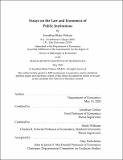| dc.contributor.advisor | Jonathan Gruber and Heidi Williams. | en_US |
| dc.contributor.author | Petkun, Jonathan Blake. | en_US |
| dc.contributor.other | Massachusetts Institute of Technology. Department of Economics. | en_US |
| dc.date.accessioned | 2020-09-03T17:43:18Z | |
| dc.date.available | 2020-09-03T17:43:18Z | |
| dc.date.copyright | 2020 | en_US |
| dc.date.issued | 2020 | en_US |
| dc.identifier.uri | https://hdl.handle.net/1721.1/127036 | |
| dc.description | Thesis: Ph. D., Massachusetts Institute of Technology, Department of Economics, May, 2020 | en_US |
| dc.description | Cataloged from the official PDF of thesis. | en_US |
| dc.description | Includes bibliographical references. | en_US |
| dc.description.abstract | This thesis consists of three chapters on the legal and economic organization of large-scale public institutions. Each chapter uses the tools of applied microeconomics in order to explore how the legal and organizational structure of public institutions affects the behavior of actors inside and outside of the organization as well as the quality of public goods provided. In other words, my thesis asks the question: how well do our public institutions function, or for whom do they function? Chapter 1 focuses on the inner-workings of the United States civil justice system; chapters 2 and 3 focus their attention on the U.S. military. In Chapter 1 I study a procedural reform in the U.S. federal trial courts. Re-cent court reform efforts in the U.S. and elsewhere have focused on speeding up what are perceived to be slow and burdensome civil justice systems. | en_US |
| dc.description.abstract | I study a Congressionally-enacted reform known as the "six-month list," which uses social pressure to incentivize federal judges to decide cases more quickly. I construct an original dataset of nearly 500,000 federal district court motions--representing the approximate universe of summary judgment motions in federal civil cases for the period 2004-2014--and I exploit quasi-random variation in exposure to the six-month list in order to assess the causal effects of the six-month list on both the speed and quality of adjudications. My results indicate that the six-month list does indeed improve speed, though the effect is heterogeneous across judges, with judges who are young, non-white, or female being among the most responsive. Meanwhile, I find only mixed evidence of effects on the quality of adjudications. I interpret these results as consistent with a model of judicial behavior that Chapter 2 maintains a focus on public sector personnel policy, bit it shifts con-texts from the U.S. | en_US |
| dc.description.abstract | courts to the U.S. military. In this chapter, which is the product of joint work with Christina Patterson and William Skimmyhorn, we study how the structure of common retention incentives affects employee quality in the U.S. military. This complements the existing literature on the determinants of public sector worker quality, which has primarily focused on levels of compensation rather than the structure of personnel policy and other non-wage incentives. We combine administrative data with quasi-random variation to find that low-ability soldiers are relatively more responsive to both lump-sum bonuses and early retirement benefits, and both effects are large enough to lower the organization's average ability level. We provide suggestive evidence that neither access to credit nor differences in personal discount rates explain these selection patterns. | en_US |
| dc.description.abstract | In Chapter 3, joint with Paul Goldsmith-Pinkham, we assess the potential for pecuniary externalities relating to military housing allowances. In providing housing to its troops, the U.S. military chooses between direct in-kind provision (i.e. on-base barracks and family housing) and cash transfers (i.e. lump-sum housing allowances). In areas with a high military share of the overall population, military housing policies can have potentially significant impacts on the local civilian housing market. Anecdotally, some worry that military housing allowances drive up local housing prices, making it difficult for civilians to compete with their military neighbors for affordable housing. We combine panel data on the evolution of ZIP code-level military housing allowances and rental and house prices with plausibly exogenous changes to the military's housing allowance formula in order to identify pecuniary externalities. | en_US |
| dc.description.abstract | We find suggestive evidence that increases to local military housing allowance rates generate sizeable pecuniary effects, with a 1% increase in military housing allowances leading to a 0.25% increase in local house prices in areas with a nearby military base. | en_US |
| dc.description.statementofresponsibility | byJonathan Blake Petkun. | en_US |
| dc.format.extent | 270 pages | en_US |
| dc.language.iso | eng | en_US |
| dc.publisher | Massachusetts Institute of Technology | en_US |
| dc.rights | MIT theses may be protected by copyright. Please reuse MIT thesis content according to the MIT Libraries Permissions Policy, which is available through the URL provided. | en_US |
| dc.rights.uri | http://dspace.mit.edu/handle/1721.1/7582 | en_US |
| dc.subject | Economics. | en_US |
| dc.title | Essays on the law and economics of public institutions | en_US |
| dc.type | Thesis | en_US |
| dc.description.degree | Ph. D. | en_US |
| dc.contributor.department | Massachusetts Institute of Technology. Department of Economics | en_US |
| dc.identifier.oclc | 1191625824 | en_US |
| dc.description.collection | Ph.D. Massachusetts Institute of Technology, Department of Economics | en_US |
| dspace.imported | 2020-09-03T17:43:17Z | en_US |
| mit.thesis.degree | Doctoral | en_US |
| mit.thesis.department | Econ | en_US |
